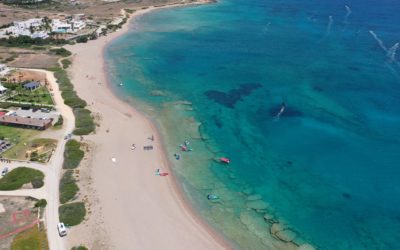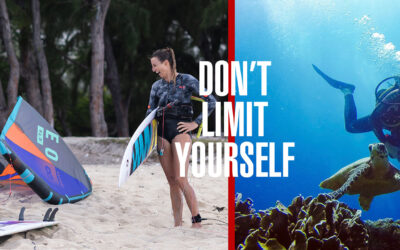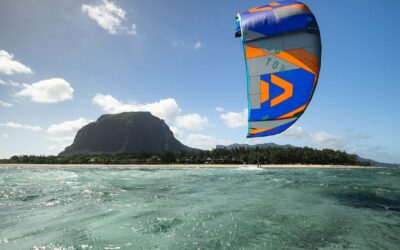What exactly is wingfoiling?
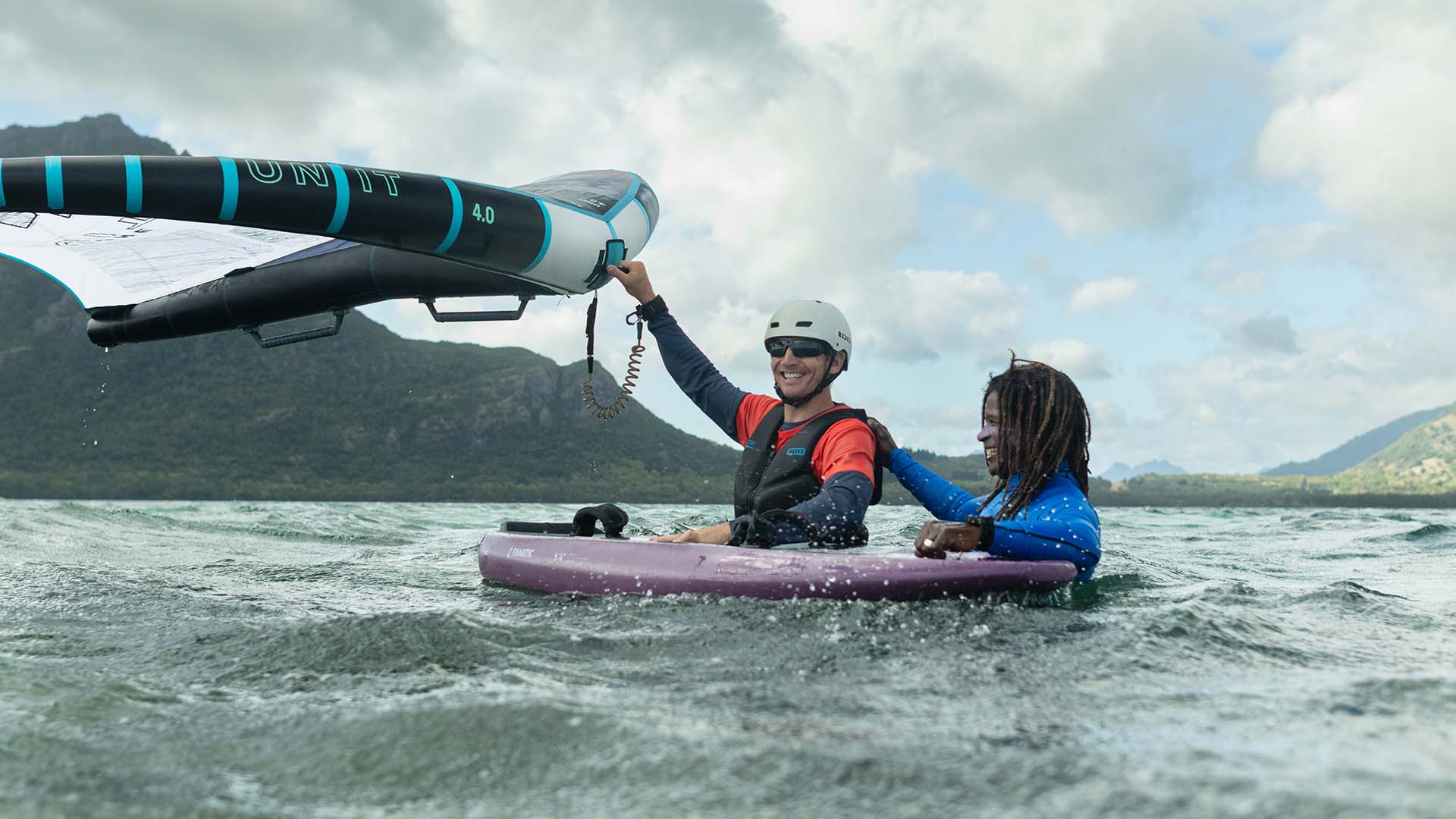
Wingfoil (or wingsurf) hit the beaches in 2019, and this ingenious activity is simply a combination of windsurfing, a little kitesurfing and of course foiling (windfoil and kitefoil). Remember, the first machines to use foils were boats, a long time ago!
Over the past few years wingfoiling has become a passion for many watersports enthusiasts, not only for thrill-seekers but also for newbies who dream of flying above the water themselves using a small wing made up of two inflatable bladders operated directly by the hands, a board under the feet, attached to the foil (a kind of keel connected to a fuselage), and two solid carbon wings of different sizes (the front wing and the stabilizer).
Thanks to speed and the magic of underwater forces, the wingfoil allows you to fly about 30 centimetres above the water when you are stable. A bit like having a magic carpet under your feet, and it is pure bliss!
Wingfoil was not born overnight, and it took many years for the activity to see the light of day. It all began in 1982 when Roland le Bail, amateur and windsurfing enthusiast, embarked on a crazy project that he called the bird sail. Equipped with a windsurf board and a sail similar to a windsurf sail, he was inspired by birds in flight. He had the idea of projecting himself into the air for a few seconds thanks to the speed provided by his new set up, which he later used on beaches with roller skates, and even on skis in the snow. Unfortunately few professionals were interested in his project, despite the support of famous Hawaiian watermen such as Robby Naish and Pete Cabrinha.
The adventure continued in the 80´s thanks in particular to the American Tom Magruder, who invented another wind weapon. Almost identical to the bird sail, the latter included a mast. This new water sports activity had yet to convince many people, let alone the general public.
However, in 2015 wingfoil finally saw the light of day thanks to American Tony Logosz’s passion for extreme water sports. Tony is also one of the creators and directors of the Slingshot kitesurfing brand. Initially a windsurfer and then a kitesurfer many years later, he drew his inspiration from a range of thrill-seeking activities in order to come up with wingfoiling. A fan of speed and of all kinds of sports technology, prototypes were created, and in 2019 wingfoil entered the market and became accessible to all.
How to choose your first wingfoil equipment
Before you spend any money, make sure that the equipment you are going to buy corresponds to your current wingfoil level, and if you are a complete novice, the best advice is to take wingfoil lessons at a center.
An apprentice wingfoiler will opt for a board equivalent to around 30 or even 40 liters more than his or her body weight. For example, someone weighing 80 kilos will sail on a 110-120 liter board, or someone weighing 60 kilos will sail on a 90 or even 100 liter board. However, if you are not a windsurfer or kitesurfer, then add an extra 10 liters. The board is the most important piece of equipment when you start wingfoiling, as it enables you to float and to keep your balance, to steer easily with the wing in your hands, and thus to move forwards on the water, even if you are not flying. For the inflatable wing, the most popular size is a 4m², which will cover a wind range of between 15 and 25 knots, more or less, depending upon your build. Let’s not forget the foil, which will give you the sensation of being in the air! The size of the mast, the front wing and the stabilizer must be taken seriously. The ideal mast for learning should measure between 70 and 75 cm in height, the front wing around 1800-1900 cm², and the stabilizer, not to be neglected, should be close to 300 cm². Note that the fuselage, which connects the front wing and the mast, should not be too long or too short. 70-75 cm in length is very good for beginners and advanced riders.
Don’t forget your leashes, one is attached to your wrist for the wing and the other to your ankle or waist for the board. A neoprene wetsuit is a must, even in good weather, so that you don’t cut yourself on the foil, and of course a helmet and impact vest to protect you from any knocks that may come your way.
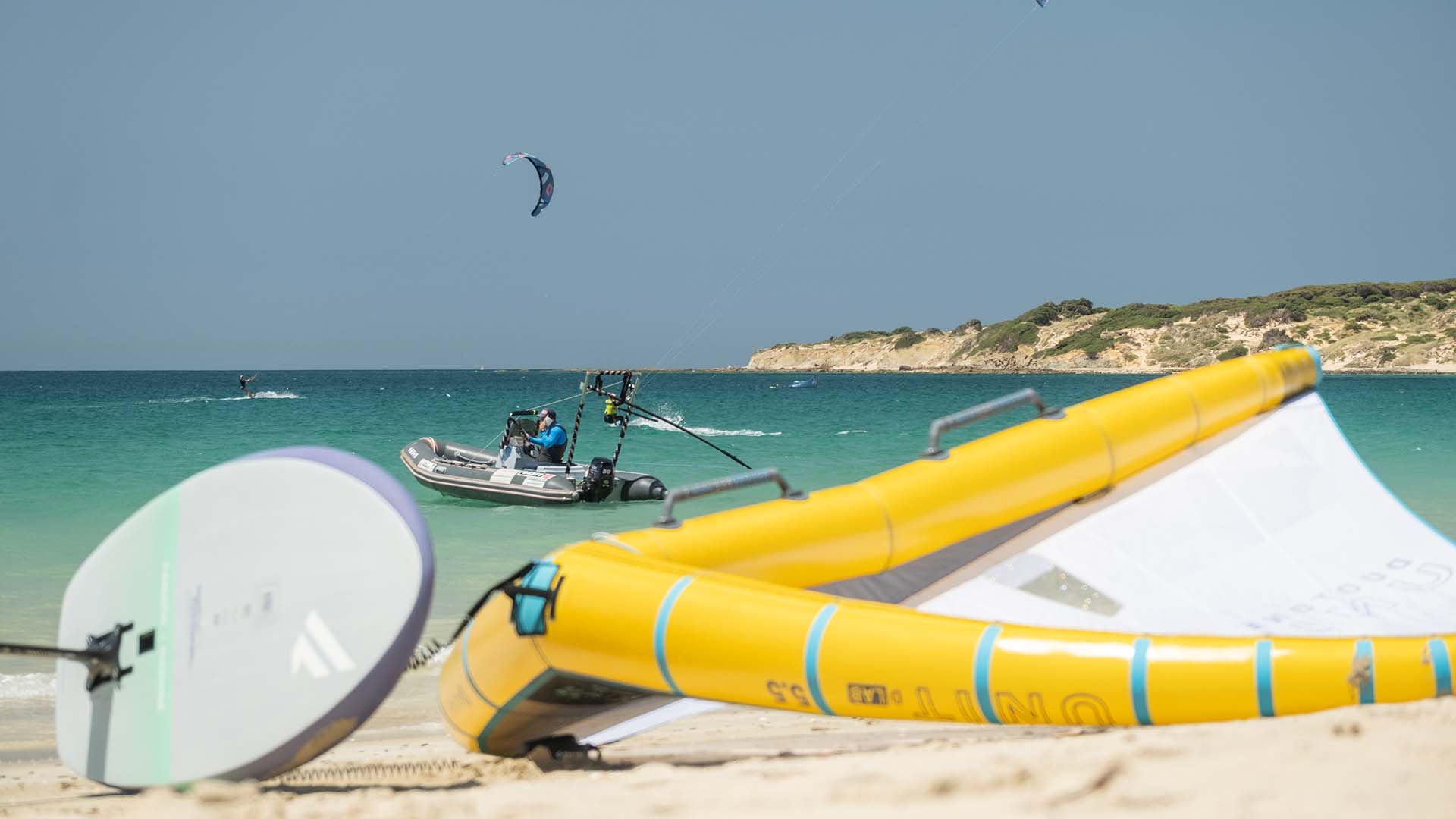
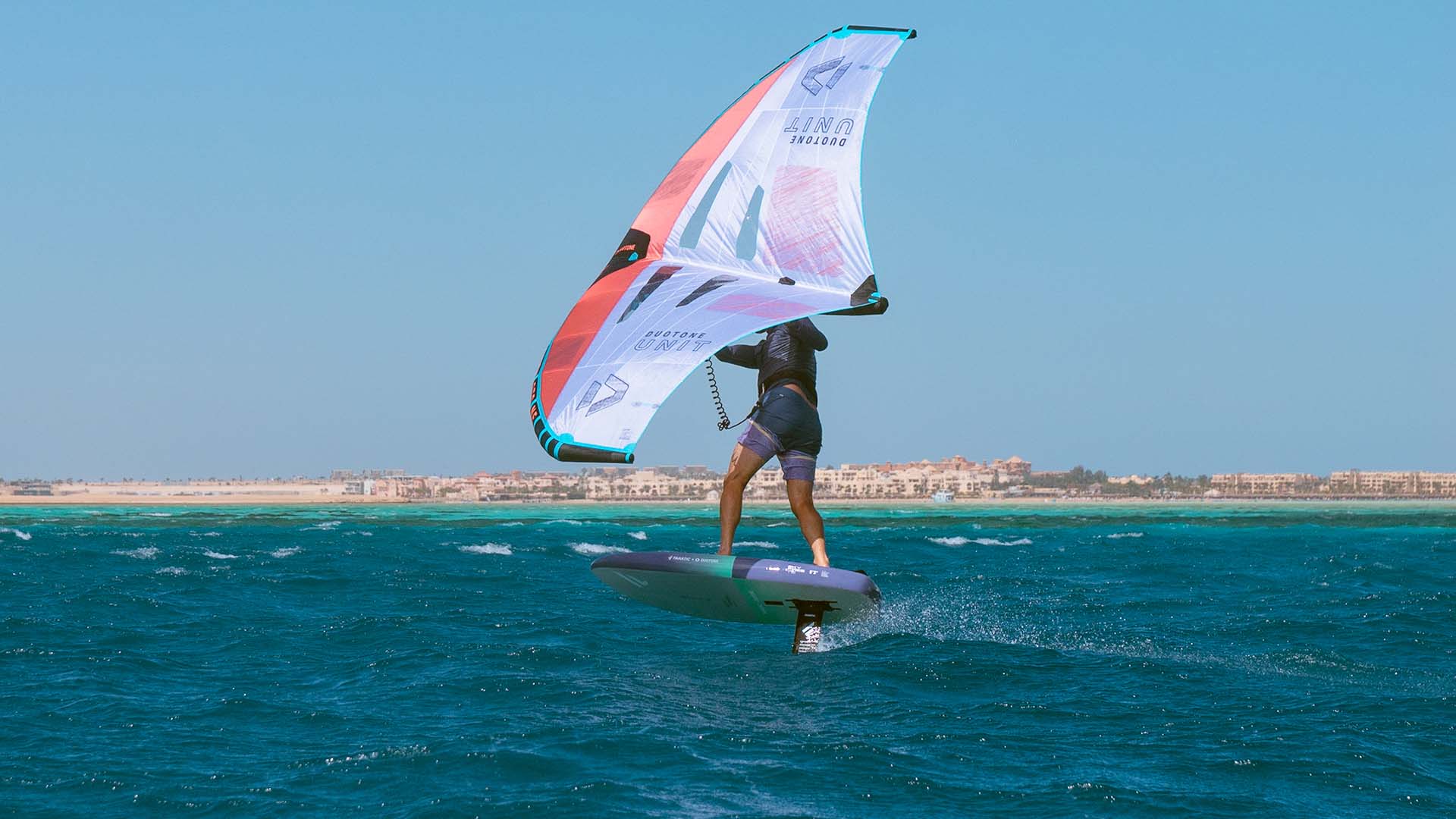
What are the best places to start wingfoiling?
You can learn to wingfoil in a lake, sea or ocean. In short, almost anywhere where there is water with enough depth so that it does not touch the bottom, and of course in restricted areas! The best advice we can give you is to always choose a spot with flat or almost flat water, and a side wind or light sea breeze (side-shore or even side-onshore) close to 20 knots, as this will make it much easier to take off and to keep planing and the stability of the board in the air. If you haven’t yet mastered upwind riding, don’t stray too far from the shore, and let someone know that you are going out on the water as if you are on the sea, you are bound to drift during your first few sessions. For a very first outing, which is sometimes done on a stand-up paddle board or a very large windsurf board (here without the foil), try to maneuver your wing in 12-13 knots in order to understand the wind.
When it comes to the bottom of the water, choose sand rather than pebbles or rocks if you are on a beach. You will be less likely to hurt yourself if you fall into shallow water, and you’ll be less likely to damage your foil.
Once again, consider taking a wingfoil course at a water sports center on a spot ideal for beginners, especially if you don’t come from a windsurfing or kitesurfing background, as progress will certainly be faster than on your own. Keep in mind the spots in Mauritius at Le Morne and Anse la Raie, Fuerteventura at Costa Calma, Cabarete in the Dominican Republic, Lassarga in Morocco, and not forgetting Tarifa and Golf de Rosas in Spain and Karpathos in Greece. These are all good locations where ION CLUB centers are located.
How long does it take to learn the basics of wingfoil?
Learning to wingfoil can be quick for some, but often takes longer for others, depending on their sailing, kiting, windsurfing or even foiling experience. It goes without saying that an experienced rider in one of these disciplines will progress more rapidly than a novice in water sports. Add to this the fact that weather conditions are not always favorable. However, with the right choice of equipment, good advice and perseverance, you will find that wingfoil isn’t too difficult a sport to at least enjoy a few tacks. Admittedly the very first sensations of gliding and stable flight comes a little later than with kitesurfing or windsurfing, but in the end you will always manage to sail, and your progress can then be huge! In full flight and at speed the magic will finally happen!
Good windsurfers and even some kitesurfers start flying for a few meters, usually after 2 or 3 sessions. Those with basic windsurfing and kiteboarding skills will take a little longer, often between 5 and 6 sessions. On the other hand, a newbie to gliding and sailing will progress much more slowly, and can usually expect to fly around ten meters after at least 10 -12 sessions. Of course, all of this is to be taken into account for someone who does it regularly, and with the right equipment, either over a full week in good weather conditions, or at least 2 or 3 times a month.
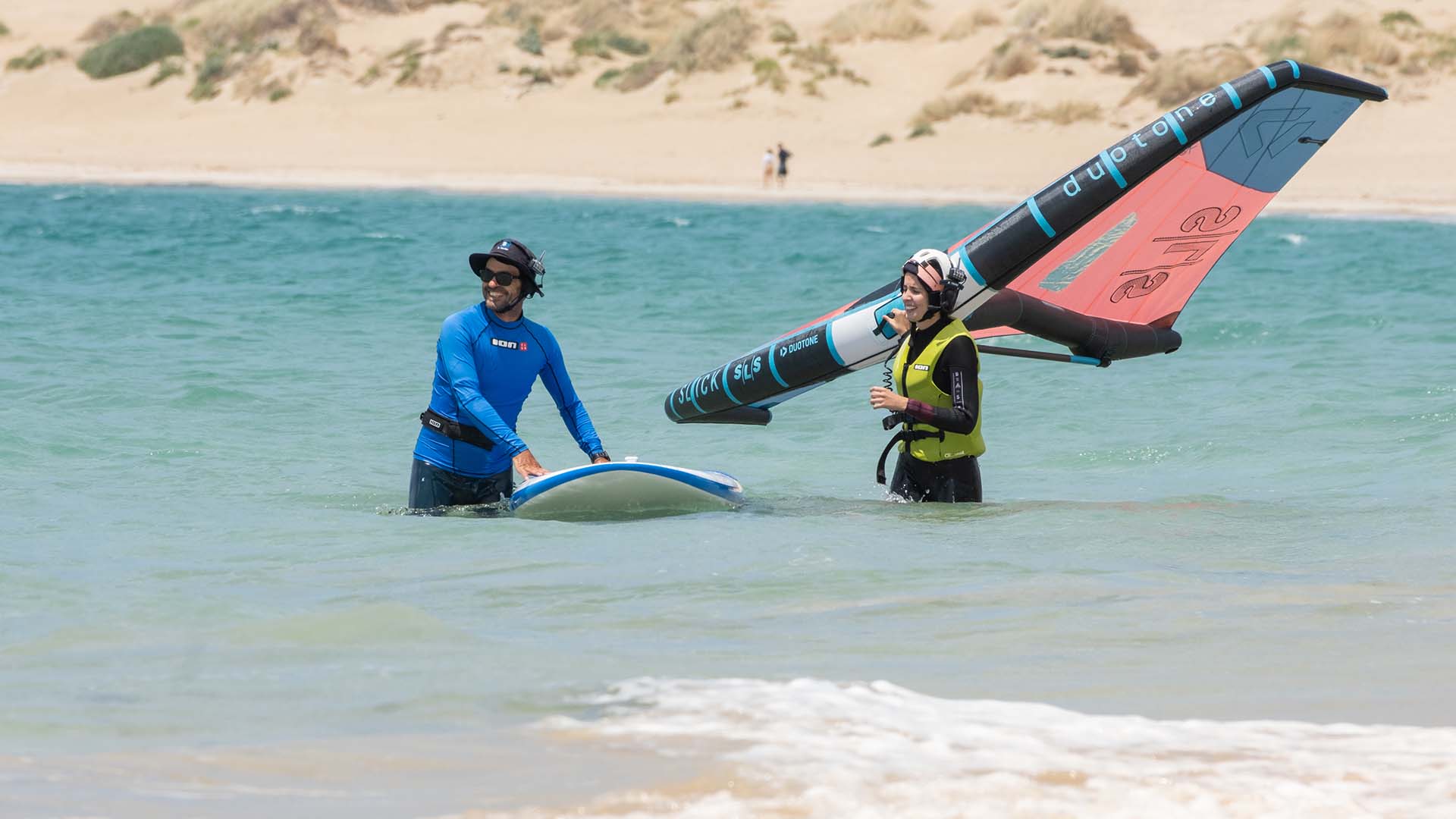
What are the common mistakes made by wingfoil beginners?
When you start wingfoiling your first impression is often that you can fly easily and with very little wind, at around 12-13 knots. This is a mistake because it is certainly enough to glide, but only when you are independent and experienced. Unless you are super light, the ideal conditions for learning to take off and fly over the water are wind speeds of at least 17-18 knots, and this advice is not to be neglected. When you buy your equipment it is important to buy a wing that is a little too big, rather than too small as it is better to be slightly overpowered than underpowered. Don’t forget that the wind is your engine.
As we have already said, take a board that is at least 30 liters larger than your body weight so that you are comfortable on it with your wing in your hands, and don’t drift too much in order to ensure your return to the beach. Those who get carried away by a board with too little volume will take longer to progress.
As for the actual foil, a front wing with a surface area closer to 2000cm² than 1500cm² is advised as this will help you to take off sooner and without forcing.
As you can see, the choice of equipment is very important, but so is the choice of the spot: Aim for sideshore wind, little or no swell, and plenty of space!
Don’t be afraid to put weight on the front of the board to stabilize it, with your feet close to the footstraps, and then back off little by little when it’s ready to take off! Stand with your buttocks slightly back and your hands hooked onto the wing, which needs to be slightly above your head for the wind to get through, and then you will be in the air in wingfoiler country!
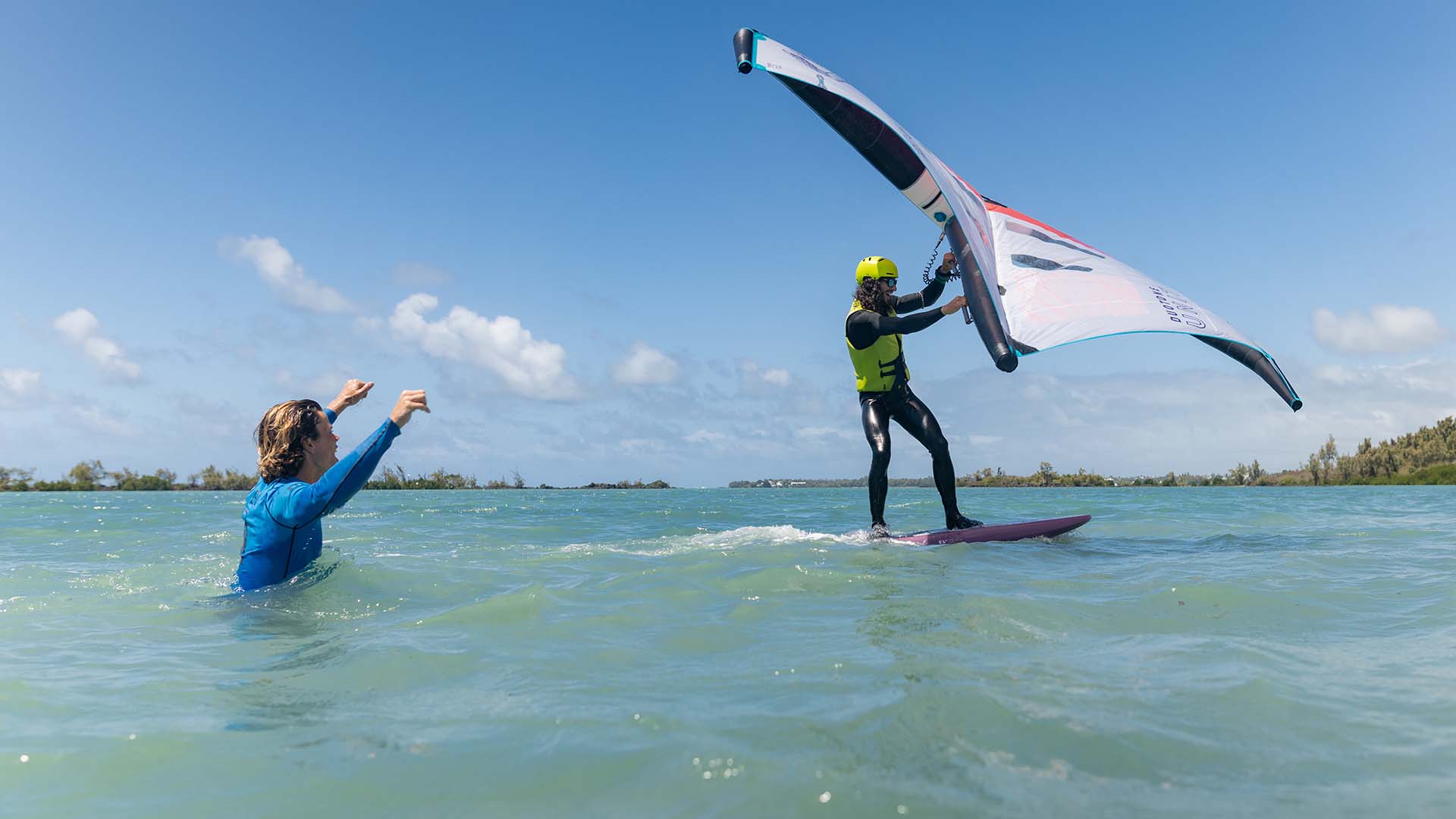
How do you ensure your safety when you start wingfoiling?
To ensure a good session, and above all your own safety on the water, the first essential thing to do when you are a wingfoil beginner (and even for independent wingfoilers) is to find out about the weather. Assess the wind strength and direction, as well as the spot and its bottom, and where to launch from. Don’t overestimate yourself, and check on the internet and with the locals whether it’s a spot with no waves or a very light chop.
Once you have reached the water’s edge check that the wing is properly inflated and that all foil screws are tight. Wetsuit and impact vest on your body, helmet on your head, and you are ready to ride! Hopefully someone close to you has heard about your outing. If, however, you get into the water and the wind is too strong, it’s best to return to the beach immediately and wait for it to calm down, or come back another day. Do not put yourself or others in danger!
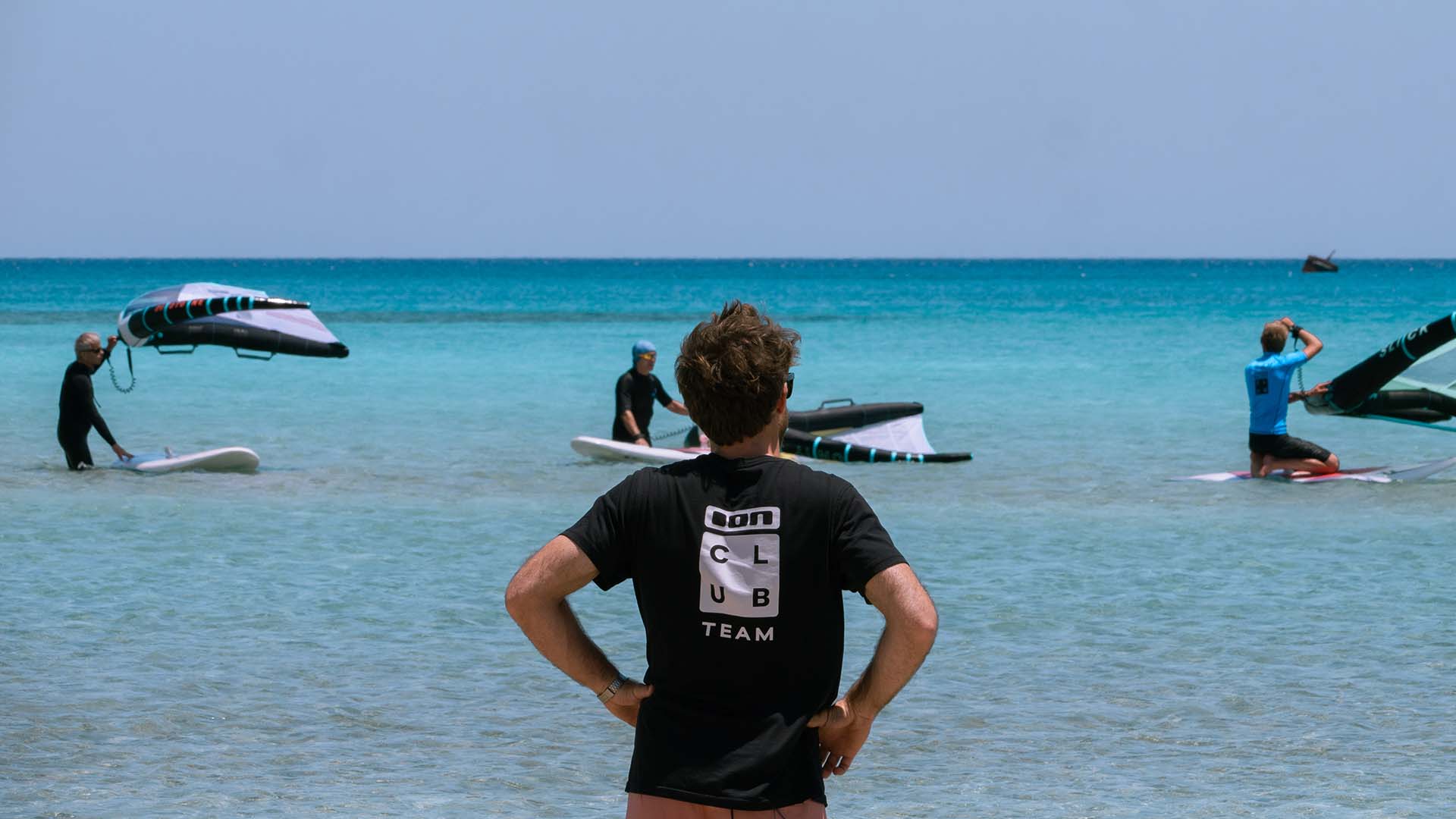
Wingfoil vs. kitesurf: What is the difference?
Wingfoil has made, and continues to make, many intermediate and advanced kitesurfers happy, and very keen to go wingfoiling whenever the weather conditions are right, sometimes even leaving their all-time favorite sport of kitesurfing to one side.
It goes without saying that a good grounding in kitesurfing will help you to make rapid progress in wingfoil. Nevertheless, windsurfing and wingfoiling are much closer to each other in terms of maneuvering and steering, due in particular to the wing held in the hands, a bit like a boom in windsurfing. This is unlike kitesurfing where there is a bar that allows you to steer your kite and be towed rather than pulled – that’s the difference!
The sensations are also different, with kitesurfing enabling beginners to glide earlier than with a wingfoil. Depending on the size of the kite, the rider will be able to glide at 12-13 knots, whereas with wingfoil you can expect to glide at 16-17 or even 18 knots, depending on your weight.
The biggest difference between these two water sports is that in wingfoil you have the ease and facility to launch almost anywhere that you want, thanks to equipment that takes up much less space on the beach and enables self-launching as assistance is not needed, and there are no more lines lying around on the beach. As you can see, when you are just starting out in kitesurfing, it is compulsory to have another person to help you to launch the kite, which is not the case in wingfoil. There are now more restricted areas for wingfoiling than there are for kiting, especially in the summer.
Speed lovers, don’t overlook kitefoiling for those who already have a good level of kitesurfing! Faster than the wing, the sensations are incredible! As for passionate wingfoilers, let them pass you by, as it will be complicated to catch up, but this pleasure of sailing, cruising and free-flying in the swell may make them jealous.
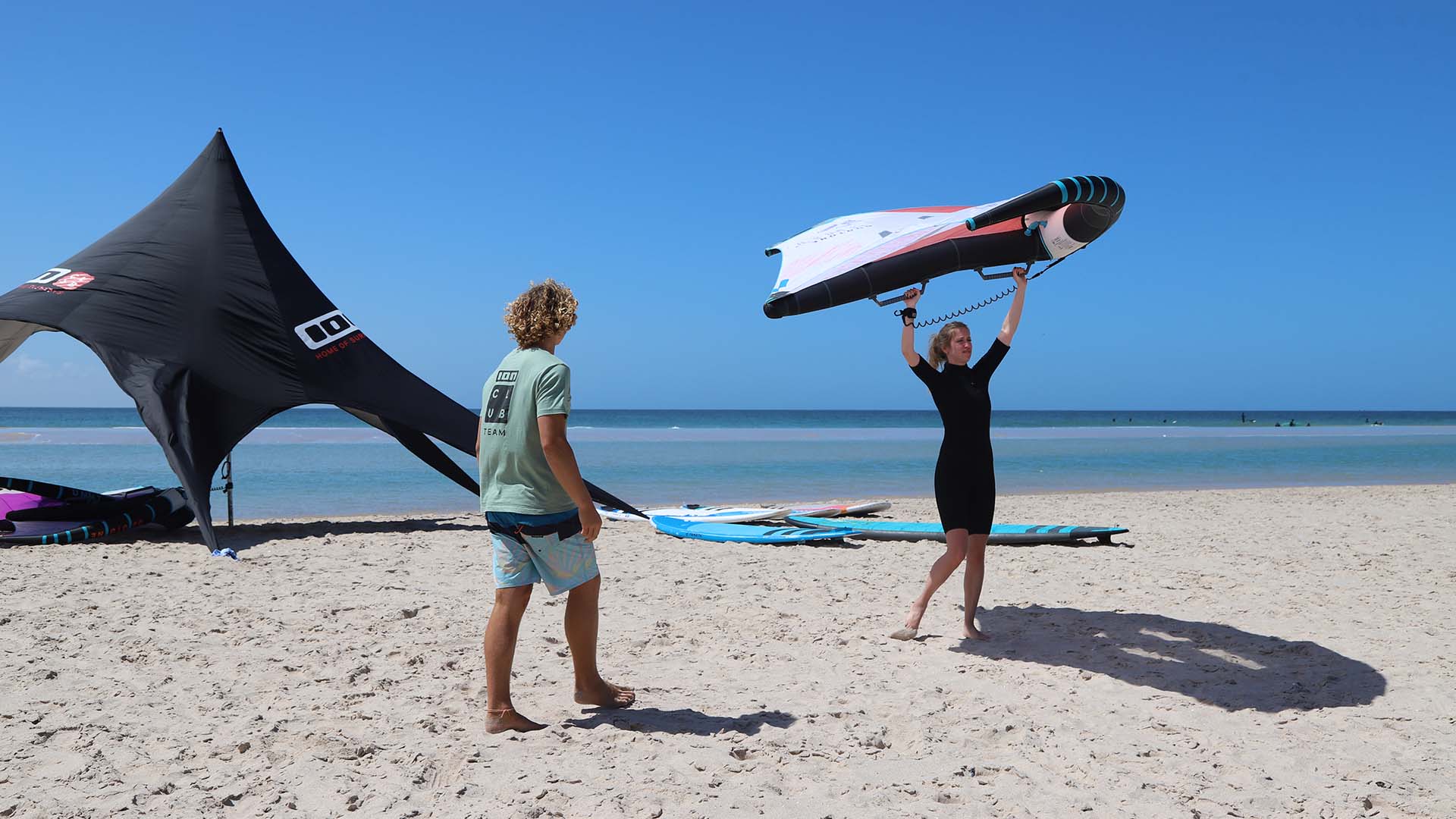
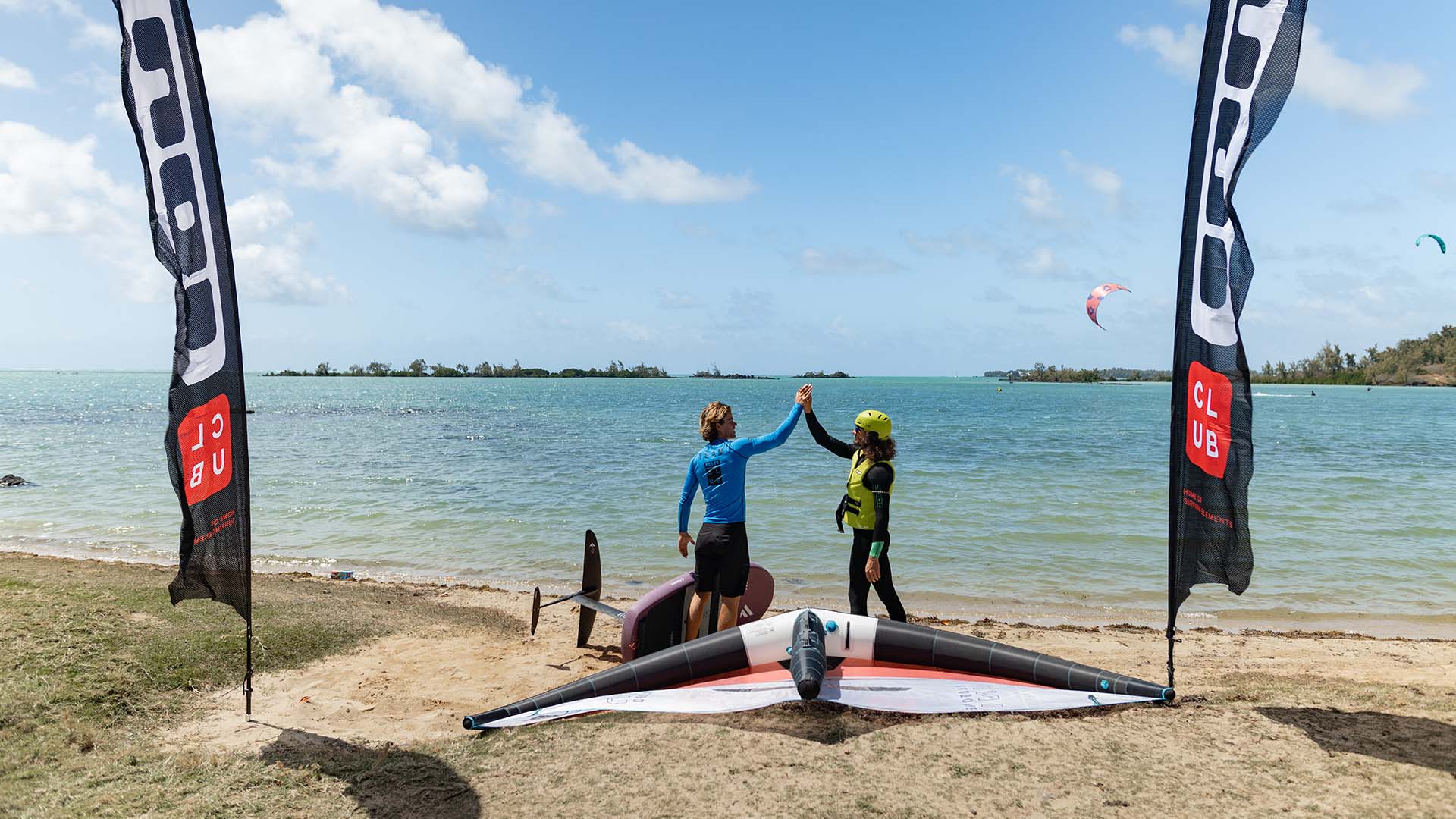
Is it possible to learn to wingfoil without watersports experience?
It is perfectly possible to learn wingfoiling without any prior watersports experience, but it is likely to take longer to learn and progress than it would for a kitesurfer or a windsurfer. You will learn how to understand the wind, and how to maneuver the wing in order to move your board forward in the first instance, which is practically a given for a kitesurfer or windsurfer from the very first moments in wingfoil. Then it is time to successfully take off from the water and fly, finding the ideal position on the board to make you an independent wingfoiler. You will also need to take an interest in the weather before any session, and it’s also very important to know how a spot works.
Also, you will also need to be at least a bit athletic because wingfoil is a sport that demands both mental and physical energy!
What is the budget for wingfoiling?
Taking up wingfoiling requires a financial sacrifice, so before embarking on this adventure taking a few lessons will help you to decide whether or not you want to continue the activity, since it is necessary to buy a complete set of equipment when you start out. This includes a board, a wing, a complete foil, and for newbies in water sports, a neoprene wetsuit with helmet and impact vest, and even neoprene booties. Fortunately many surf shops offer complete wingfoil packages, so you can get started at a lower cost than buying item by item. Since the activity has been around for quite some time now, a second-hand market has developed, and it is often more attractive to start with equipment that has already been used a little, but don’t forget to check that the equipment has not been damaged.
The overall budget for beginner wingfoil equipment (board+wing+foil) is around 1500€ (minimum) for new equipment, however, for top-of-the-range equipment, you’re looking at a minimum of 2000€ and upwards.
As you can see, wingfoiling, like windsurfing and kitesurfing, requires a great deal of thought before you get hooked on this addictive sport, but once you are into it, you become addicted and you will want more, because it is so much fun!
KARPATHOS PACKAGES
FROM SEPTEMBER 28TH TO OCTOBER 13TH 2024 ENJOY EXCLUSIVE ION CLUB PACKAGES HOTEL + SPORT + TRANSFERS Our exclusive 7- day packages offer you much more than just a stay. Immerse yourself in the experience of windsurfing or wingfoiling under the sun and on the...
SCUBA CARIBE x ION CLUB
Diving and Surfing: A Natural Collaboration for Ocean EnthusiastsWhen one thinks of the ocean, two activities immediately come to mind: diving and surfing. These two distinct passions, while different, are remarkably complementary. In Mauritius, two institutions, ION...
Kitesurfing in Mauritius: Essential info !
Mauritius, located in the Indian Ocean to the east of Madagascar, is a real treasure trove for kitesurfers. This tropical, volcanic island is not only popular with tourists in search of paradise beaches, hikers and divers, but also with kitesurfers from all over the...

